An Evolutionary Game Study of Collaborative Innovation across the Whole Industry Chain of Rural E-Commerce under Digital Empowerment
Abstract
:1. Introduction
2. Basic Assumptions and Model Construction
2.1. Model Assumptions
2.1.1. Modeling Assumptions under the Market Mechanism
2.1.2. Modeling Assumptions under Government Regulation
2.2. Collaborative Decision-Making Mechanism of the Whole Industry Chain under the Market Mechanism
2.2.1. Model Construction
2.2.2. Model Analysis
2.3. Collaborative Decision-Making Mechanism of the Whole Industry Chain under Government Regulation
2.3.1. Model Construction
2.3.2. Model Analysis
3. Case Analysis and Numerical Simulation
3.1. Collaborative Innovation Costs, Collaborative Innovation Benefits, and Motivation for Co-Innovation
3.2. Operating Cost Subsidies, Government Incentives, and Motivation for Co-Innovation
3.2.1. Adopting an Incentive: Subsidizing Operating Costs
3.2.2. Adopt an Incentive: Governmental Incentives
3.2.3. Adoption of Two Types of Incentives: Subsidized Operating Costs and Government Incentives
3.3. Potential Risk Losses, Free-Riding Gains, and Motivation for Co-Innovation
3.3.1. Potentially Risky Losses
3.3.2. Free-Rider Gains
3.4. Liquidated Damage, Government Fines, and Motivation for Co-Innovation
3.4.1. Adoption of a Safeguard: Enterprise Liquidated Damage
3.4.2. Adoption of a Safeguard: Government Fines
3.4.3. Adoption of Two Types of Safeguards: Enterprise Liquidated Damage and Government Penalties
4. Discussion
5. Conclusions and Implications
5.1. Conclusions
5.2. Contributions to Theoretical Knowledge
5.3. Practical Implications
Author Contributions
Funding
Data Availability Statement
Conflicts of Interest
References
- Basso, B.; Antle, J. Digital agriculture to design sustainable agricultural systems. Nat. Sustain. 2020, 3, 254–256. [Google Scholar] [CrossRef]
- Ciarli, T.; Kenney, M.; Massini, S.; Piscitello, L. Digital technologies, innovation, and skills: Emerging trajectories and challenges. Res. Policy 2021, 50, 104289. [Google Scholar] [CrossRef]
- Chao, P.; Biao, M.; Zhang, C. Poverty alleviation through e-commerce: Village involvement and demonstration policies in rural China. J. Integr. Agric. 2021, 20, 998–1011. [Google Scholar]
- Pengfei, F.; Tiantian, H.; Yue, Q.; Yun, W.; Jiuli, G. Research on the Construction of the Industrial Chain of China’s Rural Digital Economy. Acad. J. Bus. Manag. 2023, 5, 168–179. [Google Scholar]
- Ji, X.; Xu, J.; Zhang, H. Environmental effects of rural e-commerce: A case study of chemical fertilizer reduction in China. J. Environ. Manag. 2023, 326, 116713. [Google Scholar] [CrossRef]
- Xiao, D.; Kuang, X.; Chen, K. E-commerce supply chain decisions under platform digital empowerment-induced demand. Comput. Ind. Eng. 2020, 150, 106876. [Google Scholar] [CrossRef]
- Jiang, Y.; Zhao, X.; Zhai, L. Digital empowerment to improve the operational profitability in e-commerce supply chain. Electron. Commer. Res. Appl. 2023, 58, 101253. [Google Scholar] [CrossRef]
- Roger, G.; Vasconcelos, L. Platform pricing structure and moral hazard. J. Econ. Manag. Strategy 2014, 23, 527–547. [Google Scholar] [CrossRef]
- Plambeck, E.L.; Taylor, T.A. Supplier evasion of a buyer’s audit: Implications for motivating supplier social and environmental responsibility. Manuf. Serv. Oper. Manag. 2016, 18, 184–197. [Google Scholar] [CrossRef]
- Hiam, S.; Gilles, T. Digitalization and Platforms in Agriculture: Organizations, Power Asymmetry, and Collective Action Solutions. SSRN Electron. J. 2020. Available online: http://pub.etla.ff/ETLA-Working-Papers-78.pdf (accessed on 1 July 2024).
- Rijswijk, K.; Klerkx, L.; Bacco, M.; Bartolini, F.; Bulten, E.; Debruyne, L.; Dessein, J.; Scotti, I.; Brunori, G. Digital transformation of agriculture and rural areas: A socio-cyber-physical system framework to support responsibilisation. J. Rural Stud. 2021, 85, 79–90. [Google Scholar] [CrossRef]
- Ren, W.; Qi, F.; Tong, W. Innovative Paths for Digital Empowerment in RuralRevitalization of Ethnic Minority Areas. Int. J. Emerg. Technol. Adv. Appl. 2024, 1, 1–8. [Google Scholar] [CrossRef]
- Zou, L.; Liang, Q. Mass entrepreneurship, government support and entrepreneurial cluster: Case study of Junpu Taobao Village in China. Sch. J. Econ. Bus. Manag. 2015, 2, 1185–1193. [Google Scholar]
- Bai, D.-R. Research on sustainable development ecosystem of rural e-commerce based on ecological perspective. Fresenius Environ. Bull. 2021, 30, 2700–2709. [Google Scholar]
- Zhang, Y.; Long, H.; Ma, L.; Tu, S.; Li, Y.; Ge, D. Analysis of rural economic restructuring driven by e-commerce based on the space of flows: The case of Xiaying village in central China. J. Rural Stud. 2022, 93, 196–209. [Google Scholar] [CrossRef]
- Prajapati, D.; Chan, F.T.; Daultani, Y.; Pratap, S. Sustainable vehicle routing of agro-food grains in the e-commerce industry. Int. J. Prod. Res. 2022, 60, 7319–7344. [Google Scholar] [CrossRef]
- Zeng, Y.; Guo, H.; Yao, Y.; Huang, L. The formation of agricultural e-commerce clusters: A case from China. Growth Chang. 2019, 50, 1356–1374. [Google Scholar] [CrossRef]
- Zhu, Y.; Zhang, X.; Yan, S.; Zou, L. Research on Spatial Patterns and Mechanisms of Live Streaming Commerce in China Based on Geolocation Data. ISPRS Int. J. Geo-Inf. 2023, 12, 229. [Google Scholar] [CrossRef]
- Karine, H. E-commerce development in rural and remote areas of BRICS countries. J. Integr. Agric. 2021, 20, 979–997. [Google Scholar]
- Du, Y. Digital Intelligence Analysis for the” First Mile” of Agricultural Product E-commerce Supply Chain. Highlights Bus. Econ. Manag. 2024, 24, 50–58. [Google Scholar] [CrossRef]
- Taylor, P.D.; Jonker, L.B. Evolutionary stable strategies and game dynamics. Math. Biosci. 1978, 40, 145–156. [Google Scholar] [CrossRef]
- Wang, C.C.; Miao, J.T.; Phelps, N.A.; Zhang, J. E-commerce and the transformation of the rural: The Taobao village phenomenon in Zhejiang Province, China. J. Rural Stud. 2021, 81, 159–169. [Google Scholar] [CrossRef]
- Wang, R.; Li, X. Study on the Realistic Dilemmas and Pathways of Empowering Rural Revitalization with Digital Technology under the Goal of Common Prosperity. Acad. J. Manag. Soc. Sci. 2023, 5, 156–162. [Google Scholar] [CrossRef]
- Liu, J.; Yang, L. “Dual-Track” platform governance on content: A comparative study between China and United States. Policy Internet 2022, 14, 304–323. [Google Scholar] [CrossRef]
- Li, L.; Du, K.; Zhang, W.; Mao, J.Y. Poverty alleviation through government-led e-commerce development in rural China: An activity theory perspective. Inf. Syst. J. 2019, 29, 914–952. [Google Scholar] [CrossRef]
- Ren, H.; Liu, Z. The impact of government subsidies on R&D investment of listed companies in China’s new energy vehicle industry-based on the perspective of industrial chain. Asian J. Technol. Innov. 2024, 32, 364–390. [Google Scholar]
- Long, R.; Yang, J.; Chen, H.; Li, Q.; Fang, W.; Wang, L. Co-evolutionary simulation study of multiple stakeholders in the take-out waste recycling industry chain. J. Environ. Manag. 2019, 231, 701–713. [Google Scholar] [CrossRef]
- Chen, H.; Liu, X. The formation mechanism of green dairy industry chain from the perspective of green sustainable development. Complexity 2020, 2020, 2927153. [Google Scholar] [CrossRef]
- Huo, H.; Lu, Y.; Wang, Y. Evolutionary game analysis of low-carbon transformation and technological innovation in the cold chain under dual government intervention. Environ. Dev. Sustain. 2024, 1–28. [Google Scholar] [CrossRef]
- Yang, X.; Zhang, Y.; Li, L. Can Digital Agriculture Realize the Sustainable Development of Rural E-commerce? In Innovation of Digital Economy: Cases from China; Springer: Berlin/Heidelberg, Germany, 2023; pp. 143–151. [Google Scholar]
- Chen, M.; Long, Y.A. Empowering Rural Revitalization: Unleashing the Potential of E-commerce for Sustainable Industrial Integration. J. Knowl. Econ. 2024, 1–19. [Google Scholar] [CrossRef]
- Zhang, Z.; Garimella, A.; Fan, M. Leveraging the Social Fabric to Improve Rural E-Commerce Access. Prod. Oper. Manag. 2024, 10591478231224974. [Google Scholar] [CrossRef]
- Feng, Z. Rural E-commerce development under the background of big data. In Big Data Analytics for Cyber-Physical System in Smart City: BDCPS 2019, 28–29 December 2019, Shenyang, China; Springer: Berlin/Heidelberg, Germany, 2020; pp. 399–404. [Google Scholar]
- Zang, Y.; Hu, S.; Zhou, B.-B.; Lv, L.; Sui, X. Entrepreneurship and the formation mechanism of Taobao Villages: Implications for sustainable development in rural areas. J. Rural Stud. 2023, 100, 103030. [Google Scholar] [CrossRef]
- Li, X.; Huang, D. Research on Value Integration Mode of Agricultural E-Commerce Industry Chain Based on Internet of Things and Blockchain Technology. Wirel. Commun. Mob. Comput. 2020, 2020, 8889148. [Google Scholar] [CrossRef]
- Du, J.; Zhong, C.; Shi, Q.; Zhang, Z. Unveiling income disparities in rural E-commerce landscape: Evidence from China. Sustain. Futures 2024, 8, 100243. [Google Scholar] [CrossRef]
- Zhong, Y.; Lai, I.K.W.; Guo, F.; Tang, H. Research on government subsidy strategies for the development of agricultural products E-commerce. Agriculture 2021, 11, 1152. [Google Scholar] [CrossRef]
- Friedman, D. Evolutionary games in economics. Econom. J. Econom. Soc. 1991, 59, 637–666. [Google Scholar] [CrossRef]
- Couture, V.; Faber, B.; Gu, Y.; Liu, L. E-Commerce Integration and Economic Development: Evidence from China; National Bureau of Economic Research: Cambridge, MA, USA, 2018; Volume 24383. [Google Scholar]
- Weibull, J.W. Evolutionary Game Theory; MIT Press: Cambridge, MA, USA, 1997. [Google Scholar]
- Kolokoltsov, V.N.; Malafeyev, O.A. Understanding Game Theory: Introduction to the Analysis of Many Agent Systems with Competition and Cooperation; World Scientific: Singapore, 2020. [Google Scholar]
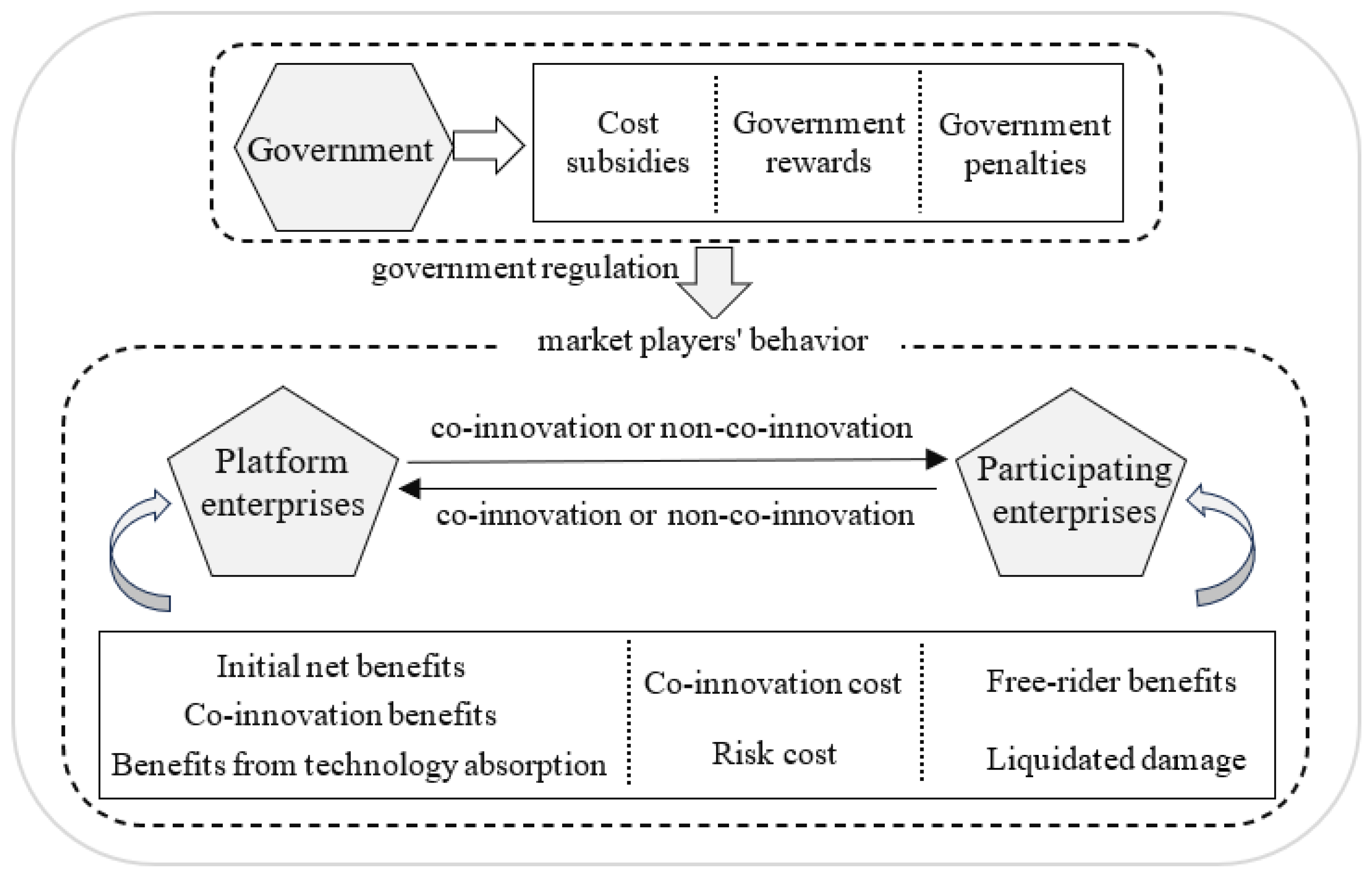
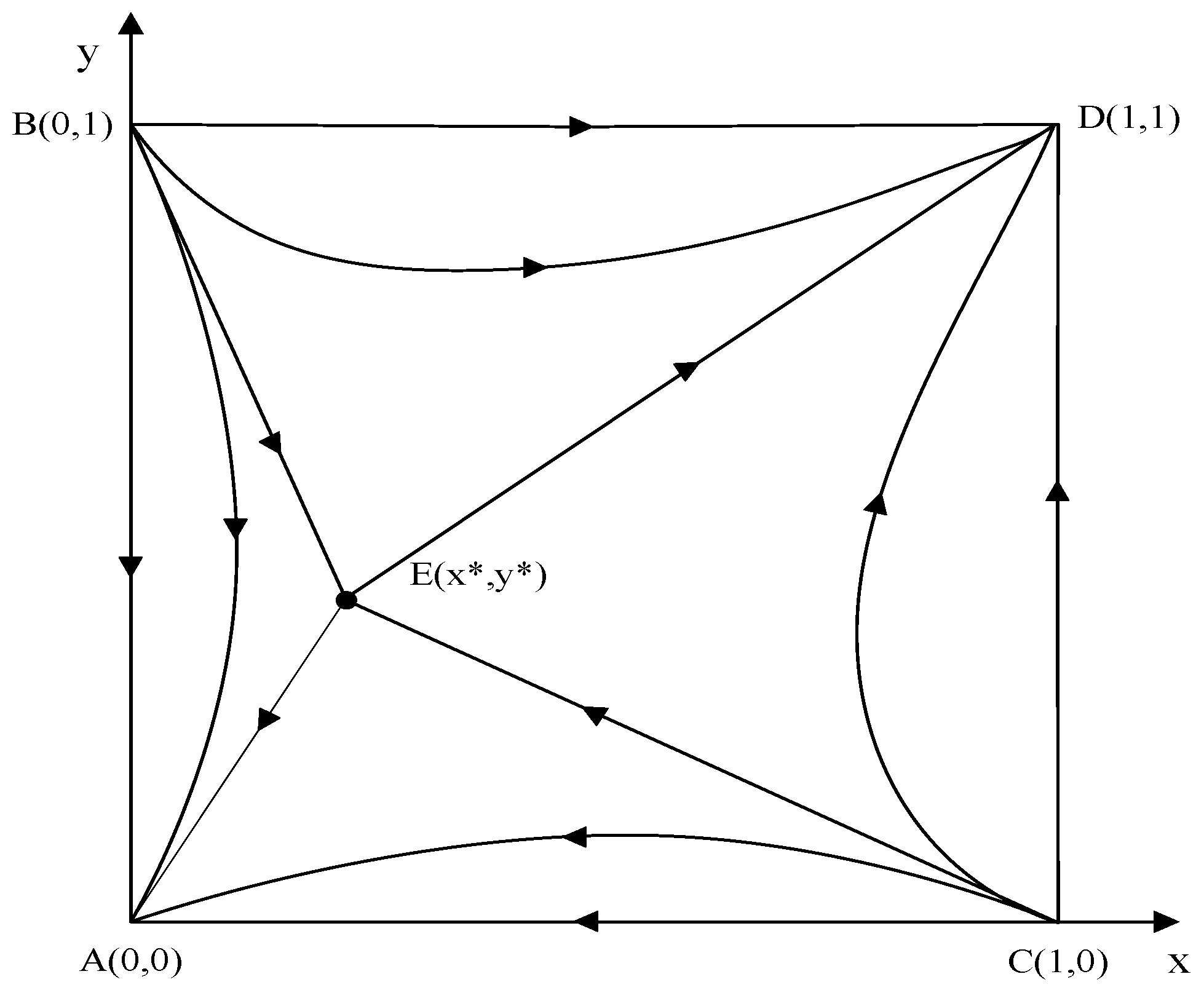
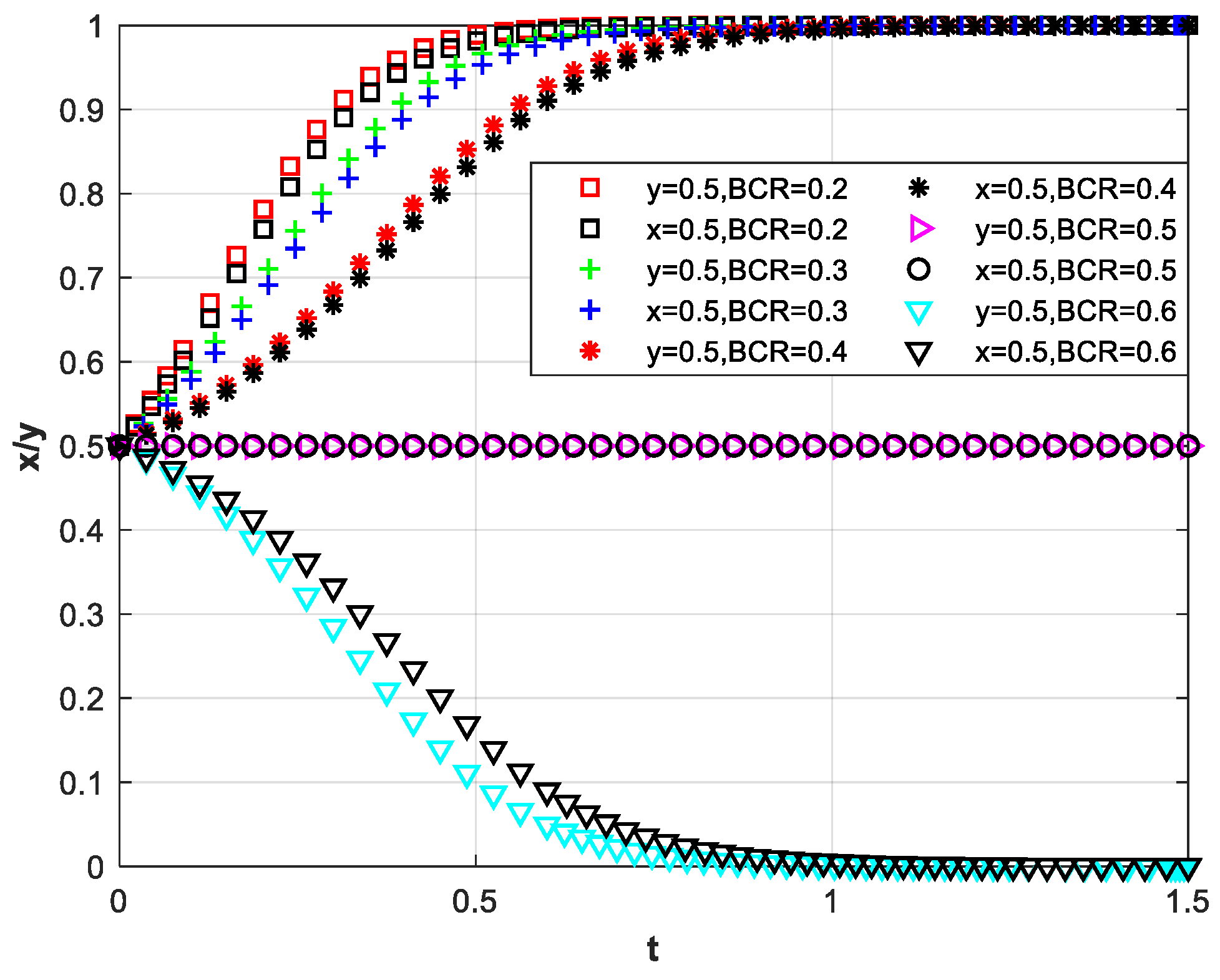

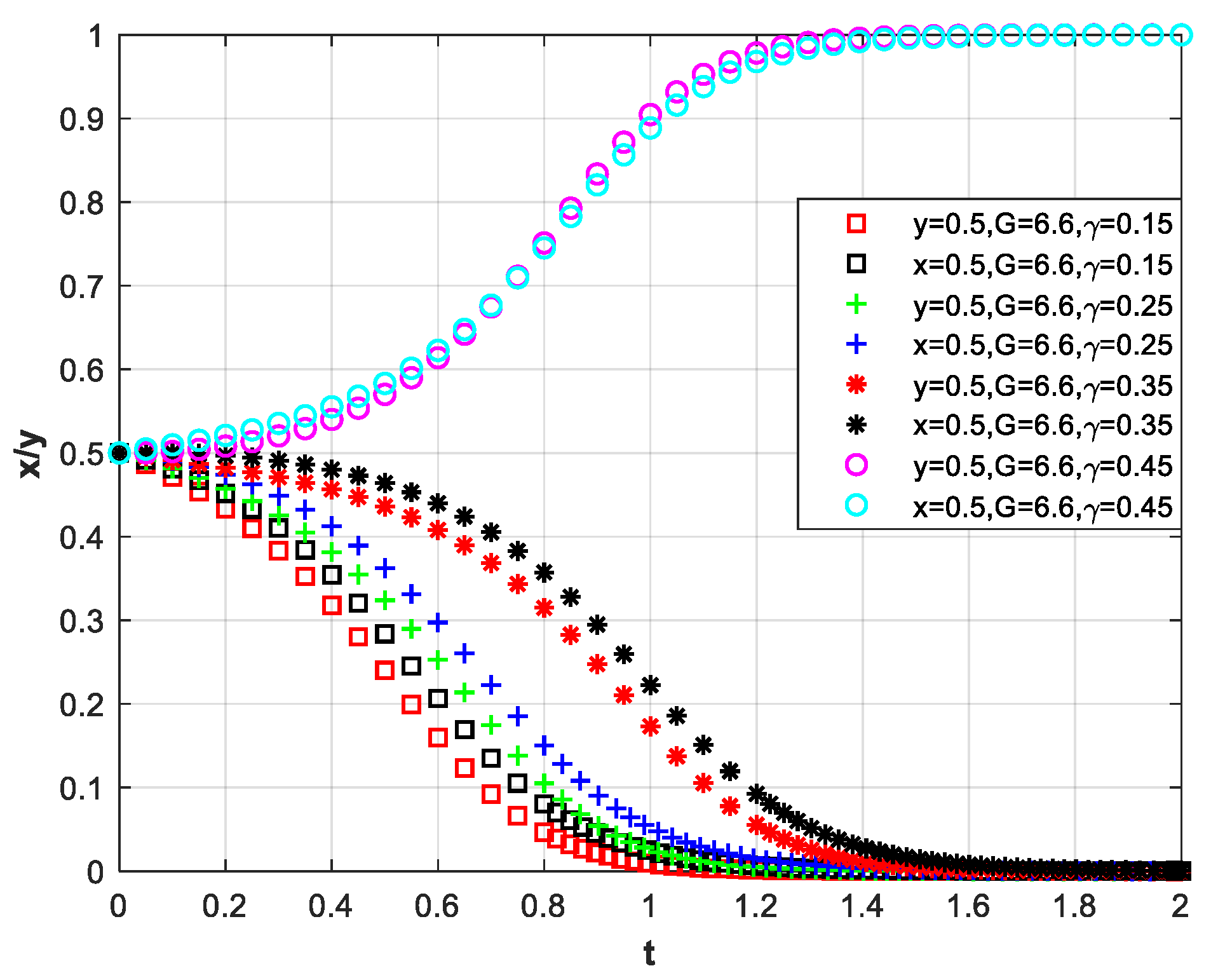
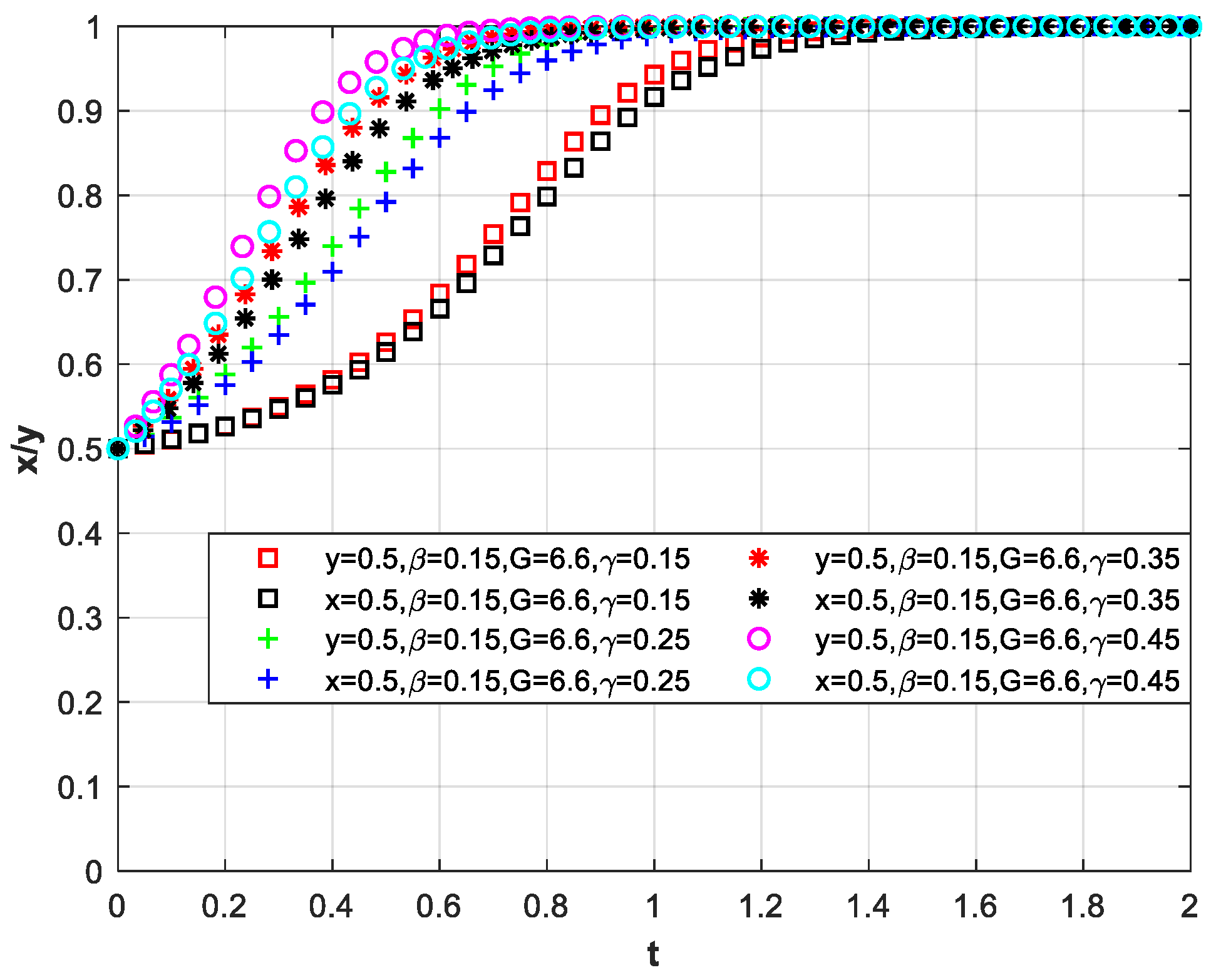
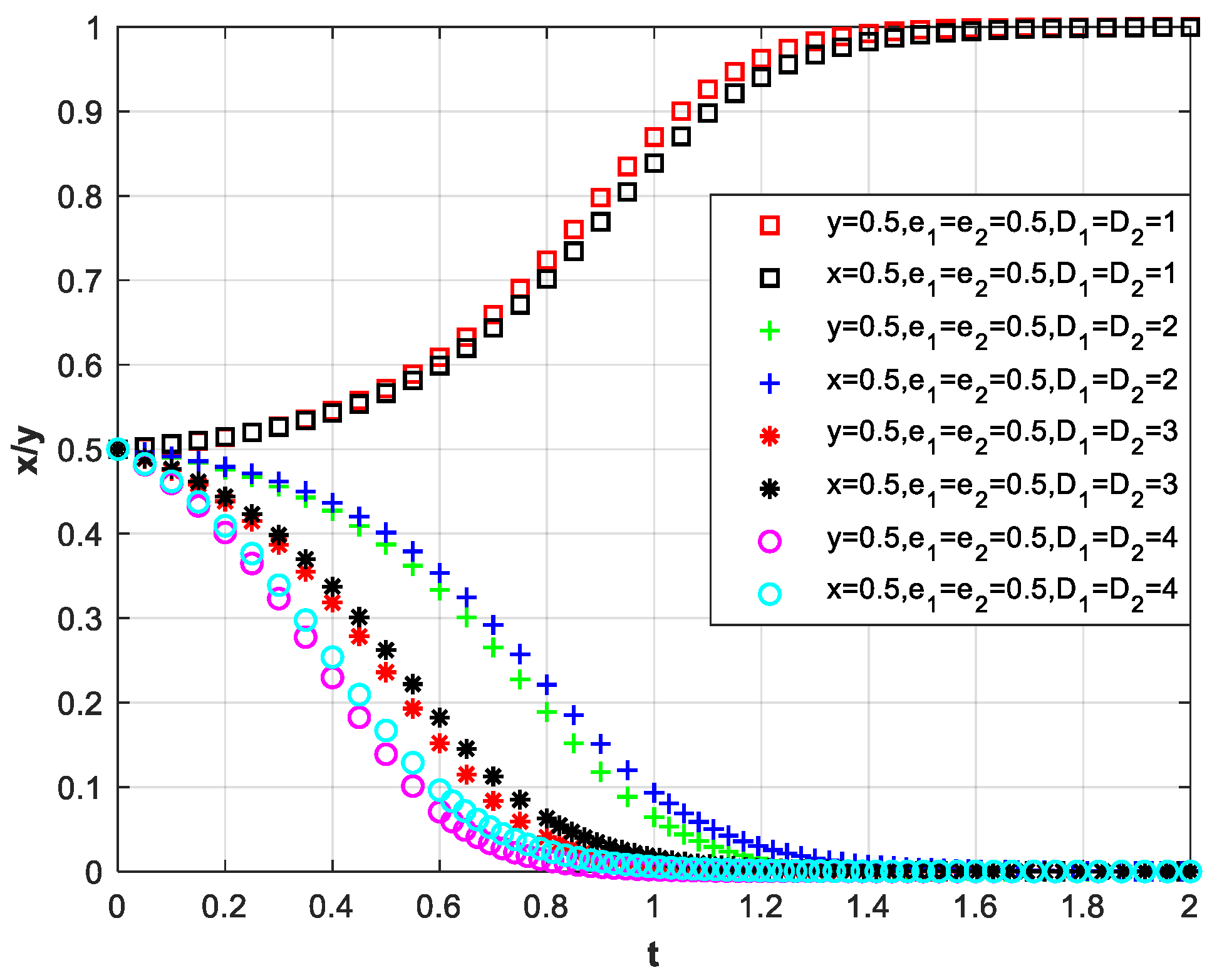

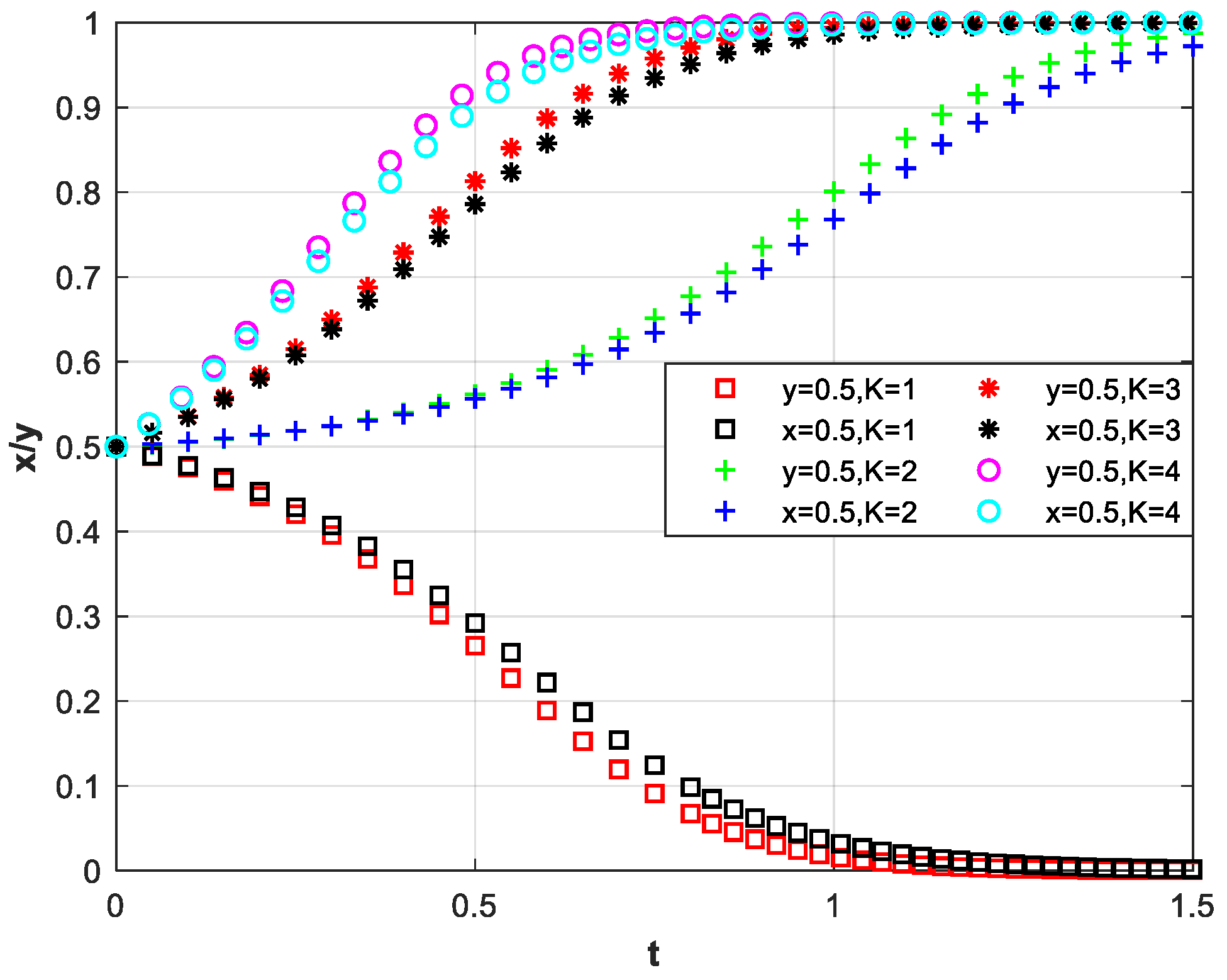
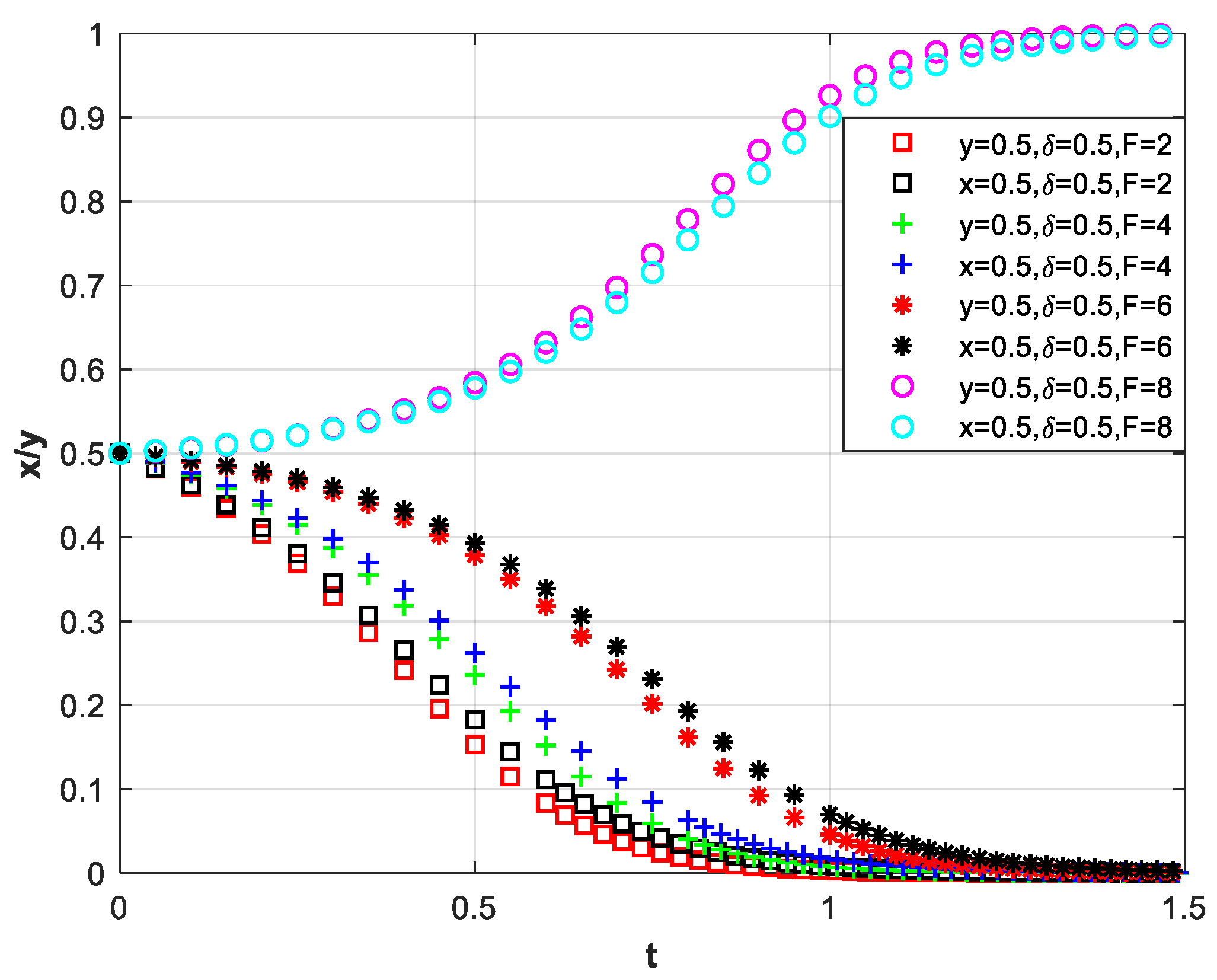

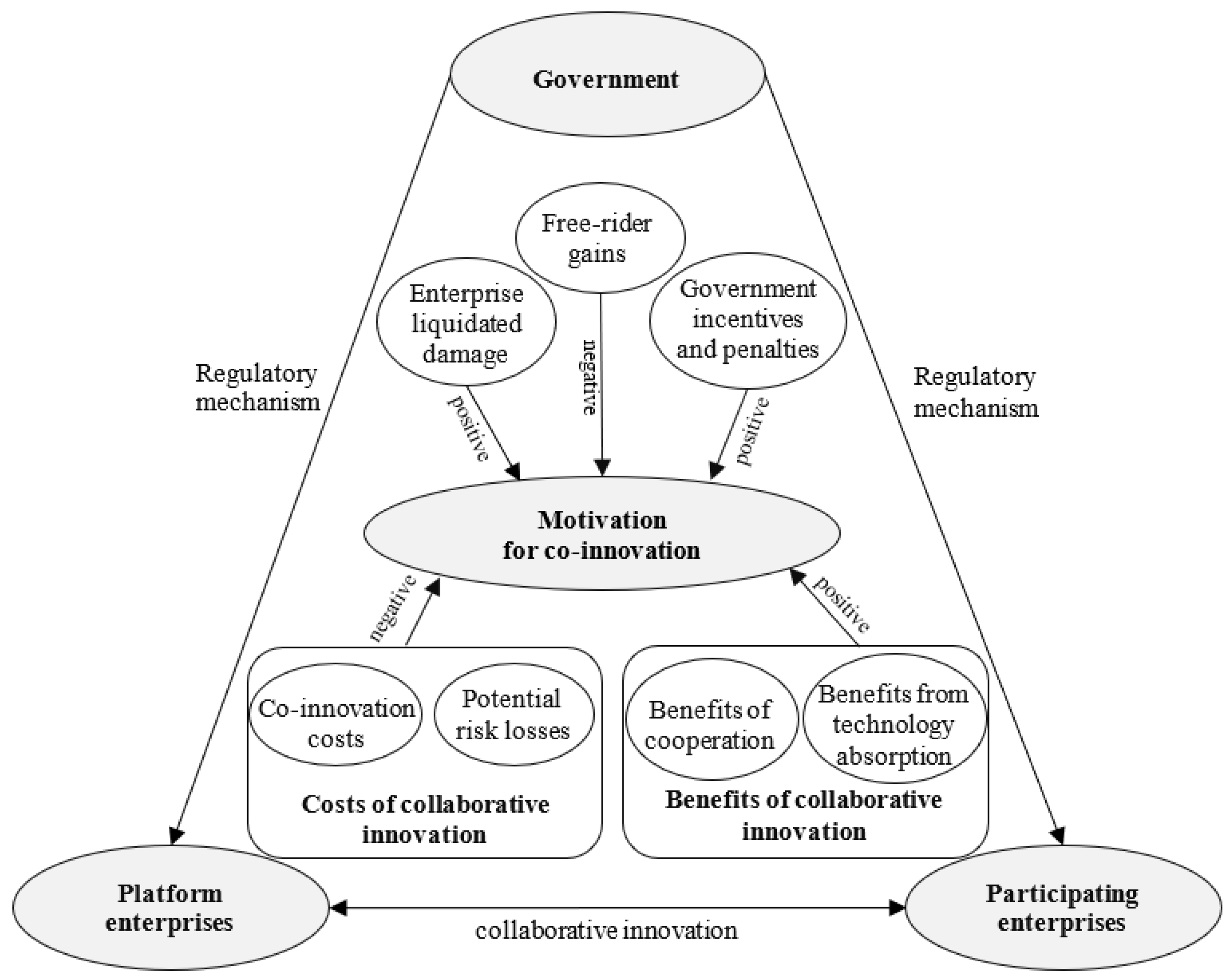
| Parameter Symbols | Description | Parameter Symbols | Description |
|---|---|---|---|
| The probability of platform enterprises participating in collaborative innovation | The probability of participating enterprises engaging in co-innovation | ||
| The initial net benefits to platform enterprises before gaming | The initial net benefits to participating enterprises before gaming | ||
| The digital technology empowerment coefficient | The amount of information generated by collaborative innovation | ||
| Coefficients for the distribution of benefits from co-innovation among platform enterprises and participating enterprises | The amount of technology generated by co-innovation | ||
| Technology absorptive capacity coefficients for platform enterprises | Technology absorptive capacity coefficients of participating enterprises | ||
| Input costs for platform enterprises to participate in collaborative innovation | Input costs for participating enterprises to engage in co-innovation | ||
| Platform enterprises’ “free-rider” benefits | “Free-rider” benefits for participating enterprises | ||
| Potentially risky losses for platform enterprises | Potentially risky losses of participating enterprises | ||
| Risk factor for platform enterprises | Risk factor for participating enterprises | ||
| Liquidated damages for non-participants | Intensity of government incentives | ||
| Government incentive base | Government regulatory efforts | ||
| Government fines | Government cost subsidization efforts |
| Participating Enterprises | |||
|---|---|---|---|
| Co-Innovation () | Non-Co-Innovation () | ||
| Platform enterprises | Co-innovation () | ||
| Non-co-innovation () | |||
| Equilibrium | ||
|---|---|---|
| 0 |
| Equilibrium | Results | ||
|---|---|---|---|
| + | − | ESS | |
| + | + | Unstable point | |
| + | + | Unstable point | |
| + | − | ESS | |
| − | 0 | Saddle point |
| Participating Enterprises | |||
|---|---|---|---|
| Co-Innovation () | Non-Co-Innovation () | ||
| Platform enterprises | Co-innovation () | ||
| Non-co-innovation () | |||
| Equilibrium | Results | ||
|---|---|---|---|
| + | − | ESS | |
| + | + | Unstable point | |
| + | + | Unstable point | |
| + | − | ESS | |
| − | 0 | Saddle point |
| Cost–Benefit Ratio (BCR) | |||||||||
|---|---|---|---|---|---|---|---|---|---|
| Scenario 1 | 3 | 2.2 | 10 | 1 | 0.5 | 10 | 1 | 0.6 | 0.2 |
| Scenario 2 | 4.5 | 3.3 | 10 | 1 | 0.5 | 10 | 1 | 0.6 | 0.3 |
| Scenario 3 | 6 | 4.4 | 10 | 1 | 0.5 | 10 | 1 | 0.6 | 0.4 |
| Scenario 4 | 7.5 | 5.5 | 10 | 1 | 0.5 | 10 | 1 | 0.6 | 0.5 |
| Scenario 5 | 9 | 6.6 | 10 | 1 | 0.5 | 10 | 1 | 0.6 | 0.6 |
Disclaimer/Publisher’s Note: The statements, opinions and data contained in all publications are solely those of the individual author(s) and contributor(s) and not of MDPI and/or the editor(s). MDPI and/or the editor(s) disclaim responsibility for any injury to people or property resulting from any ideas, methods, instructions or products referred to in the content. |
© 2024 by the authors. Licensee MDPI, Basel, Switzerland. This article is an open access article distributed under the terms and conditions of the Creative Commons Attribution (CC BY) license (https://creativecommons.org/licenses/by/4.0/).
Share and Cite
Wang, Y.; Xu, J.; Zhang, G. An Evolutionary Game Study of Collaborative Innovation across the Whole Industry Chain of Rural E-Commerce under Digital Empowerment. Systems 2024, 12, 353. https://doi.org/10.3390/systems12090353
Wang Y, Xu J, Zhang G. An Evolutionary Game Study of Collaborative Innovation across the Whole Industry Chain of Rural E-Commerce under Digital Empowerment. Systems. 2024; 12(9):353. https://doi.org/10.3390/systems12090353
Chicago/Turabian StyleWang, Yanling, Junqian Xu, and Guangsheng Zhang. 2024. "An Evolutionary Game Study of Collaborative Innovation across the Whole Industry Chain of Rural E-Commerce under Digital Empowerment" Systems 12, no. 9: 353. https://doi.org/10.3390/systems12090353
APA StyleWang, Y., Xu, J., & Zhang, G. (2024). An Evolutionary Game Study of Collaborative Innovation across the Whole Industry Chain of Rural E-Commerce under Digital Empowerment. Systems, 12(9), 353. https://doi.org/10.3390/systems12090353





